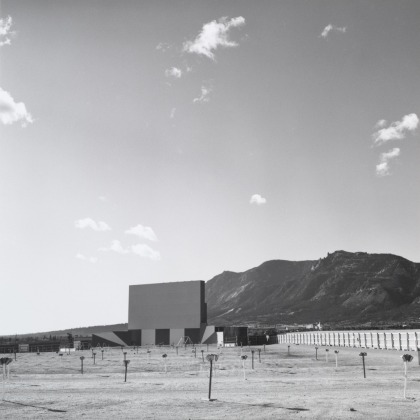This Ain’t Ansel Adams
March 3, 2014

Robert Adams, Outdoor Theater and Cheyenne Mountain, 1968 (Fraenkel Gallery)
I just finished teaching a unit on landscape photography. Like my students, I don’t find landscapes to be intrinsically interesting—it doesn’t matter how majestic the scene or how dynamic the photograph. Until, that is, we get to the 1970s. Then we get to landscapes like this.
Robert Adams is particularly compelling to me, and not just because he took lots of photos in Colorado Springs where I grew up (I swear, for example, that I went to a movie at THAT drive-in sometime in high school). No, I am really intrigued by the questions his photographs seem to ask.
Take this one.
The photograph has three parts: the dirt, the sky, and the band between them. He includes a LOT of sky, with tuffs of clouds that add texture but also pull that part of the photo forward. The dirt has texture too, of course, and poles that draw the viewer into the image (if not into the actual space in the photo).
Adams situates his camera so that the top edge of the screen intersects the contour of the mountain just as the range descends sharply, so the screen’s sharp edge becomes the horizon until it again intersects the gradual incline of the earth on the left. The continuity of the resulting band is enhanced by the similar gray values across the whole width. Only the dark vertical line on the right edge of the screen offers a firm break between nature’s spectacle and a human-made one.
Which I think is the point. The Colorado front range is a spectacle. From any window on the west side of my childhood home, I could watch the mountains change throughout the day. On almost every afternoon in the spring a little drama would unfold as a weather front moved through, bringing huge dark clouds, lightening, and sheets of rain. Even without weather, the movement of the sun would change the appearance and the feel of those mountains.
I did watch. But not often. Certainly not often enough.
I think too often I was caught up in other things to pay attention. Too busy watching human-made spectacles, perhaps.
In photos like this, Adams was documenting the new topography that humans had created. It is easy to read some criticism about how humans have ruined nature, but I think this photo could also point to the fact that it is often precisely because of human insertions into the landscape that we actually notice the beauty of the land. Just look at me right now. I’m not sure I would have given a photograph of Cheyenne Mountain a second look without the screen, the fence, and the speaker poles.
Looking at this photo, I’m feeling nostalgic and regretful. I don’t have a panoramic view of the Colorado Rockies anymore. Oh, to be able to tell my 16-year-old self sitting at that kitchen table to slow down, look out, and just watch.
I can’t do that, but I can try to pay attention now–in the not-quite-as-spectacular landscape where I live now. I can tell my 42-year-old self to slow down, look out, and watch.

 Perhaps this is why, when I look at these paintings, my eye tends to gravitate towards the figure in the middle of the center panel—the one below the sun. He looks up at God with an expression of awe and admiration. On my better days, I feel like him. He is very aware of the great power and authority of God. And so he seems just slightly nervous, as if he’s not quite sure what to expect next, but he wants to keep close. His eyes are wide open. His eyes are fixed upon God.
Perhaps this is why, when I look at these paintings, my eye tends to gravitate towards the figure in the middle of the center panel—the one below the sun. He looks up at God with an expression of awe and admiration. On my better days, I feel like him. He is very aware of the great power and authority of God. And so he seems just slightly nervous, as if he’s not quite sure what to expect next, but he wants to keep close. His eyes are wide open. His eyes are fixed upon God.
